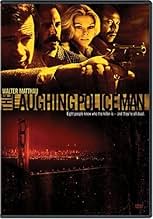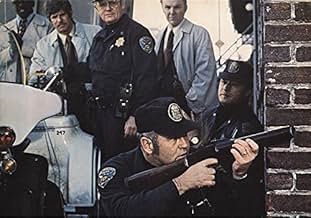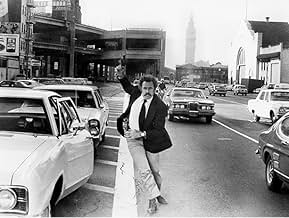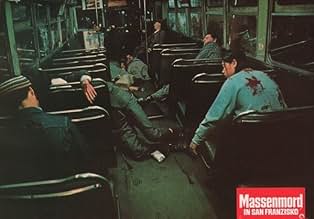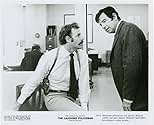VALUTAZIONE IMDb
6,4/10
3415
LA TUA VALUTAZIONE
A San Francisco, in California, una delle vittime di un omicidio di massa è un detective della polizia. Il suo partner e un nuovo assistente indagano negli ambienti malfamati della città.A San Francisco, in California, una delle vittime di un omicidio di massa è un detective della polizia. Il suo partner e un nuovo assistente indagano negli ambienti malfamati della città.A San Francisco, in California, una delle vittime di un omicidio di massa è un detective della polizia. Il suo partner e un nuovo assistente indagano negli ambienti malfamati della città.
Louis Gossett Jr.
- Larrimore
- (as Lou Gossett)
Don Borisenko
- Collins
- (as Jonas Wolfe)
Frances Lee McCain
- Prostitute
- (as Lee McCain)
Trama
Lo sapevi?
- QuizAccording to Bruce Dern's autobiography, it was Walter Matthau's idea to have Dern, known mainly as a character actor, share top billing with him for this film, a gesture for which Dern was most grateful.
- BlooperThe actual gun used in the film is a Smith & Wesson M76 9mm machine gun without the barrel shroud and not an M3 .45 caliber "Grease Gun" made by GM Guide Lamp Division for WWII use. The omission of the barrel shroud gives the appearance of an M3. If one sticks to the story line, the M3 magazine held 30 rounds .45 ACP and cycled around 450 rpm. This is sufficient to inflict the damage and wounds shown in the film.
- Citazioni
Insp. James Larrimore SFPD: [to pimp he has just pushed to the floor] Whatever you're reaching for better be a sandwich, 'cause you're gonna have to eat it!
- ConnessioniEdited into The Green Fog (2017)
Recensione in evidenza
I saw this movie today for the Xth time. As usual, I liked it a lot. So I looked this movie up on imdb.com, to see what they had to say, and was surprised at their Summary for this movie: `Dreary, Empty-Headed Crime Drama.'
I beg to differ. I have always loved this movie. It was released in 1973. It is a perfect picture of San Francisco in the mid-70's. I was there and I recognize everything in it--people, places, and attitudes. This is the pre-AIDS, pre-Yuppie, free-wheeling, getting-used-to-it San Francisco that I loved.
The director (Jack Sommersby) has taken the usual poetic license with the locations, so that the No. 14 Mission bus miraculously goes to Chinatown, and the Transamerica Pyramid is a good view from the Transbay Bus Terminal, but never mind. Any long-time San Franciscan will recognize the sights.
Further, and even better, this is a movie of subtleties--perhaps that is why the IMDB reviewer found it dreary. We are not hit in the face with expository material. The dialogue is not used to describe what can be shown. Early in the movie, the police are confronted with a bus of dead people. Getting on the bus, nobody says `It stinks in here.' Instead, one of the policemen says to the medical examiner, who is smoking a cigar, `Blow some of that smoke over here.' And, without comment, the ME does so. That is how we know it stinks in the bus.
As the policemen look closely at the dead people on the bus, they find that one of them is a policeman. It is, in fact, Matthau's partner. But they never say to each other (and therefore to us) that this victim is a policeman. They show it only in their reactions. Someone says, `My God! It's Hansen!' or words to that effect. `What is he doing on a bus?' and other dialogue let us know that this man is a policeman.
This is a happy change from the tedious obviousness of movies that are full of lines like, `You know, Jack, you are a happy-go-lucky person. Your face shows it.' Jack sits there like the lump he is, looking neither happy nor unhappy. We have to believe the speaker, because the acting isn't going to give us this information. A good director would eliminate this line, and get some happy-face acting from Jack.
It is good to see a movie directed by someone who thinks we are smart enough to get the point without being hit over the head with it. The advice usually given to beginning writers is also good for experienced directors: Don't tell us. Show us.
The laughing policeman is Bruce Dern--new to homicide investigations, and without subtleties. He laughs a lot. Matthau is the old-timer, who never laughs. He is also not a subtle person, but he is at least cautious. They are the beagle puppy and experienced retriever of the world of murder. They are oil and water, definitely not blending.
The plot is absurd, but it hardly matters. It is the chase. It is the location. It is the ambience (dreadful, overused word, but there it is; it is the right word) that counts in this movie.
Finding it on TV is hard these days. I found it recently on Black Starz TV. Fortunately for us all, Lou Gossett, Jr. is in it, so it will show up on channels catering to African Americans. Hunt for it. It's worth it.
IMDB.com uses the 10-star rating system. Following their lead, I give it 5 stars for plot, and 9 stars for faithful depiction of a time and place.
I beg to differ. I have always loved this movie. It was released in 1973. It is a perfect picture of San Francisco in the mid-70's. I was there and I recognize everything in it--people, places, and attitudes. This is the pre-AIDS, pre-Yuppie, free-wheeling, getting-used-to-it San Francisco that I loved.
The director (Jack Sommersby) has taken the usual poetic license with the locations, so that the No. 14 Mission bus miraculously goes to Chinatown, and the Transamerica Pyramid is a good view from the Transbay Bus Terminal, but never mind. Any long-time San Franciscan will recognize the sights.
Further, and even better, this is a movie of subtleties--perhaps that is why the IMDB reviewer found it dreary. We are not hit in the face with expository material. The dialogue is not used to describe what can be shown. Early in the movie, the police are confronted with a bus of dead people. Getting on the bus, nobody says `It stinks in here.' Instead, one of the policemen says to the medical examiner, who is smoking a cigar, `Blow some of that smoke over here.' And, without comment, the ME does so. That is how we know it stinks in the bus.
As the policemen look closely at the dead people on the bus, they find that one of them is a policeman. It is, in fact, Matthau's partner. But they never say to each other (and therefore to us) that this victim is a policeman. They show it only in their reactions. Someone says, `My God! It's Hansen!' or words to that effect. `What is he doing on a bus?' and other dialogue let us know that this man is a policeman.
This is a happy change from the tedious obviousness of movies that are full of lines like, `You know, Jack, you are a happy-go-lucky person. Your face shows it.' Jack sits there like the lump he is, looking neither happy nor unhappy. We have to believe the speaker, because the acting isn't going to give us this information. A good director would eliminate this line, and get some happy-face acting from Jack.
It is good to see a movie directed by someone who thinks we are smart enough to get the point without being hit over the head with it. The advice usually given to beginning writers is also good for experienced directors: Don't tell us. Show us.
The laughing policeman is Bruce Dern--new to homicide investigations, and without subtleties. He laughs a lot. Matthau is the old-timer, who never laughs. He is also not a subtle person, but he is at least cautious. They are the beagle puppy and experienced retriever of the world of murder. They are oil and water, definitely not blending.
The plot is absurd, but it hardly matters. It is the chase. It is the location. It is the ambience (dreadful, overused word, but there it is; it is the right word) that counts in this movie.
Finding it on TV is hard these days. I found it recently on Black Starz TV. Fortunately for us all, Lou Gossett, Jr. is in it, so it will show up on channels catering to African Americans. Hunt for it. It's worth it.
IMDB.com uses the 10-star rating system. Following their lead, I give it 5 stars for plot, and 9 stars for faithful depiction of a time and place.
I più visti
Accedi per valutare e creare un elenco di titoli salvati per ottenere consigli personalizzati
- How long is The Laughing Policeman?Powered by Alexa
Dettagli
- Data di uscita
- Paese di origine
- Lingua
- Celebre anche come
- The Laughing Policeman
- Luoghi delle riprese
- 156 Robinhood Drive, San Francisco, California, Stati Uniti(Jake Martin's home)
- Azienda produttrice
- Vedi altri crediti dell’azienda su IMDbPro
Botteghino
- Budget
- 2.280.000 USD (previsto)
Contribuisci a questa pagina
Suggerisci una modifica o aggiungi i contenuti mancanti

Divario superiore
By what name was L'ispettore Martin ha teso la trappola (1973) officially released in India in English?
Rispondi

